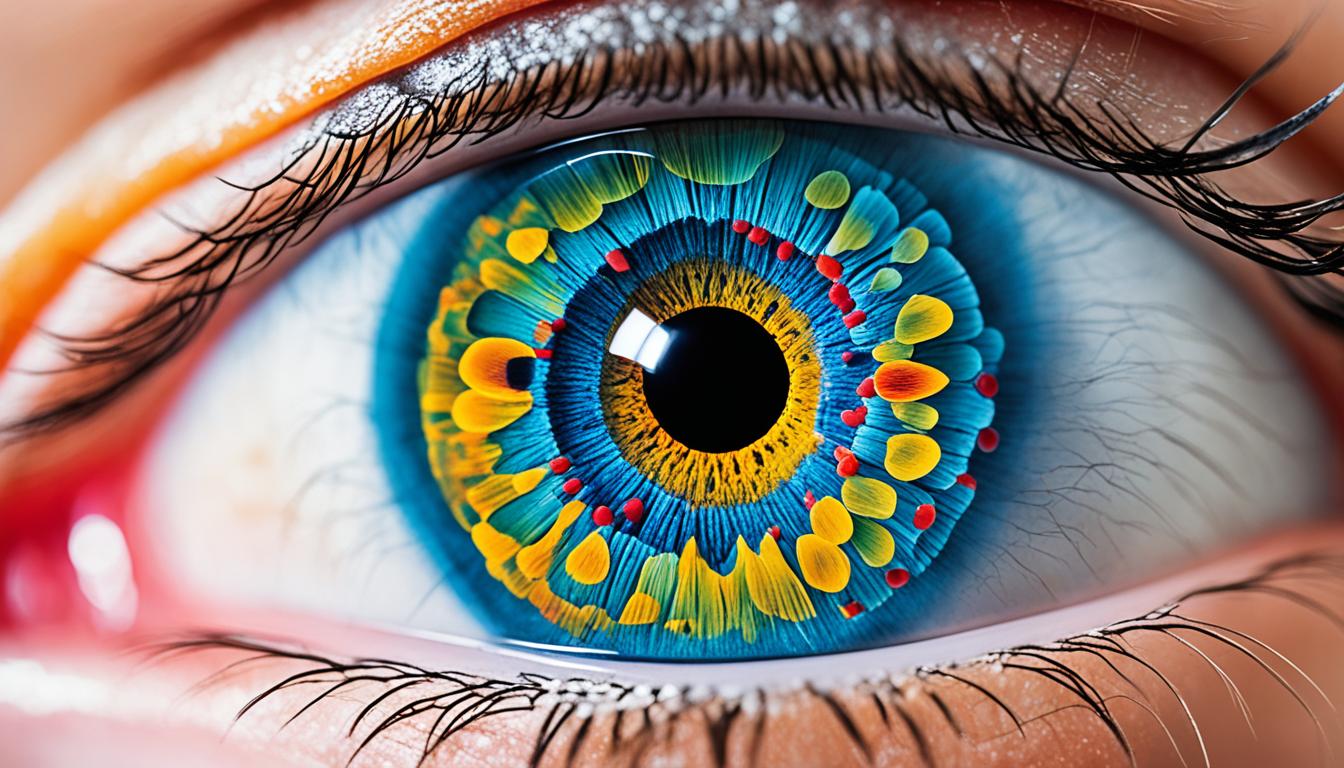Retinoblastoma is a rare eye cancer that starts in the retina. The retina is at the back of the eye and full of nerves. It mostly happens in kids under three years old. They might have a white pupil, eyes that don’t line up, or red and painful eyes.
This cancer can be passed from parents or not. If it’s passed down, kids get it earlier. The key culprit is changes in the RB1 gene on chromosome 13. Doctors usually find it by checking the eyes. They might also use MRI, ultrasound, and genetic tests.
For treatment, doctors can use local treatments, chemo, radiation, or surgery. Stem cell therapy is also under study. It’s important to spot and treat this cancer early. Most kids with retinoblastoma get better.
Key Takeaways:
- Retinoblastoma is a rare malignant tumor that develops in the retina.
- The disease primarily affects young children under the age of three.
- Common symptoms of retinoblastoma include leukocoria, strabismus, redness, and eye pain.
- The disease can be heritable or non-heritable, with heritable cases usually diagnosed at a younger age.
- Retinoblastoma is caused by mutations in the RB1 gene located on chromosome 13.
Signs and Symptoms of Retinoblastoma
Retinoblastoma is a rare eye cancer that often affects young kids. It’s important to know its signs early. This can lead to quick treatment.
Leukocoria is a main sign. It makes the eye appear white in photos with flash. If you see this in your child, get medical help fast.
Strabismus, or crossed eyes, is also common. If you notice eye misalignment, it could point to retinoblastoma.
Other signs of retinoblastoma include:
- Eye pain: Kids might feel pain in the eye with cancer.
- Redness: Red eyes could mean there’s a problem inside.
- Poor vision: The cancer might lead to blurry or less clear vision.
- Eye abnormalities: It can cause pupil changes, color differences, or an eye that bulges.
If you see these signs, see a pediatric eye doctor. A quick diagnosis can save your child’s vision. Early treatment is key to beating retinoblastoma.
| Symptoms | Description |
|---|---|
| Leukocoria | White pupil reflex caused by the reflection of light off the tumor’s white surface. |
| Strabismus | Misalignment of the eyes, also known as crossed eyes. |
| Eye pain | Discomfort or pain in the affected eye(s). |
| Redness | Presence of inflammation or vascular changes in the eyes. |
| Poor vision | Blurry vision or decreased visual acuity. |
| Eye abnormalities | Differences in pupil size, eye color changes, or bulging of the eyeball. |
Causes and Genetics of Retinoblastoma
Retinoblastoma is mainly caused by changes in the gene called RB1. This gene is on chromosome 13. These changes trigger the development of this rare eye cancer in kids.
Two types of this cancer are known: hereditary and sporadic. If there are changes in the RB1 gene that come from a parent, it’s hereditary. This form usually affects both eyes. Non-inherited changes in the gene cause sporadic retinoblastoma.
About 85% of the time, if only one eye is affected, it’s random and sporadic. But if both eyes are affected, it’s usually because of an inherited change in the RB1 gene. This difference in how the cancer spreads is key for its treatment and prediction.
The main causes of these gene changes are yet to be fully understood. They seem to happen by chance and are not linked to anything external or how a person lives. Clearly, retinoblastoma is mainly a result of genetic issues.
Quick genetic tests can find out if a child’s retinoblastoma is linked to the RB1 gene. This helps doctors decide on the best treatment plan according to whether the condition is inherited or not.
RB1 Gene Mutation and Retinoblastoma
The RB1 gene’s main job is to control cell division and stop abnormal cell growth in the eye. When there are changes in this gene, it can’t do its work well. This leads to uncontrolled eye cell growth, causing retinoblastoma tumors.
Changes in the RB1 gene can be passed from a parent or happen early in life without a known cause. If there’s a history of the disease in a family, the risk of getting it is higher. Otherwise, it usually happens out of the blue.
Learning about how the RB1 gene changes can lead to better treatments. Targeted therapies offer hope for those with retinoblastoma.
Comparison of Hereditary and Sporadic Retinoblastoma
| Hereditary Retinoblastoma | Sporadic Retinoblastoma | |
|---|---|---|
| Cause | RB1 gene germline mutations | RB1 gene non-inherited mutations |
| Tumor Growth | Bilateral (affects both eyes) | Unilateral (affects one eye) |
| Family History | Often present | Usually absent |
| Prognosis | More likely to have multiple tumors | Generally fewer tumors |
Conclusion
Retinoblastoma is a rare eye cancer affecting young kids. Early diagnosis greatly improves chances of a cure. Symptoms may include a white pupil, crossed eyes, and eye pain. So, it’s vital for parents to act fast if these signs show in their child’s eyes.
Mutations in the RB1 gene cause this cancer, often leading to it affecting both eyes. Diagnosis involves eye exams and may include genetic testing. This helps doctors check for gene mutations and plan the right treatment.
Retinoblastoma is treated with various methods, including surgery and chemotherapy. There is also hope in using stem cells for treatment. Thankfully, most children with this cancer survive and go on to live without it.
Ongoing check-ups are crucial to catch any return of the cancer early. Working closely with the healthcare team is key. This ensures children with retinoblastoma get the best care and have a hopeful future.

